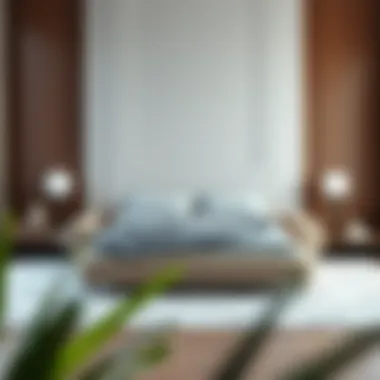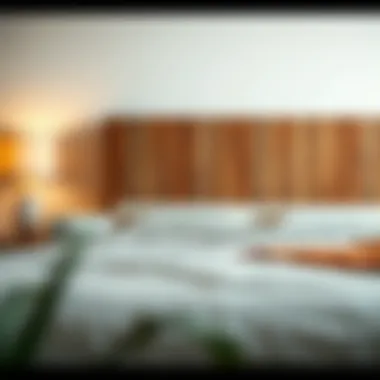The Bed with a Sofa at the End: Exploring Design and Utility


Intro
In the realm of bedroom design, the integration of a sofa at the end of the bed encapsulates a harmonious blend of comfort and practicality. This unique furnishing choice isn't merely about aesthetics; it brings a functional dimension to the sleeping space. A sofa can serve as a cozy reading nook, a place to throw on an outfit, or even an extra seating space for guests. This article will thoroughly explore various furniture design styles that suit this concept, alongside practical tips for homeowners looking to elevate their bedroom's style and efficiency.
Furniture Design Styles
Overview of Popular Styles
When considering the incorporation of a sofa at the end of a bed, understanding the various design styles can guide your selections. Here are some popular styles:
- Modern: Characterized by sleek lines, modern sofas tend to emphasize minimalism and functionality. A low-profile sofa can create a contemporary feel, blending seamlessly with clean linens and geometric decor.
- Traditional: If your bedroom has a more classic design, a traditional style sofa upholstered in rich fabrics can add an elegant touch. These sofas often feature ornate details that complement could complement antique furniture pieces.
- Bohemian: A boho-style sofa adorned with colorful throws and eclectic patterns can introduce a playful vibe. This is perfect for those looking to create a relaxing and unique atmosphere.
- Mid-Century Modern: Featuring organic shapes and light woods, a mid-century modern sofa can be a statement piece. This style effortlessly combines nostalgia with contemporary design, making it a popular choice among decorators.
Understanding these styles helps to create a cohesive aesthetic. Consider your bedroom's existing decor when making choices, allowing the sofa to enhance rather than overwhelm the space.
How to Mix and Match Styles
Mixing styles can elevate your design game, creating an individualized and inviting environment. Here are a few tips on how to blend various design styles:
- Balance Elements: If you lean towards a modern bed frame, pairing it with a traditional fabric sofa can create an eye-catching contrast. Striking the right balance is key to a harmonious look.
- Common Colors: Use a similar color palette across different styles to maintain visual coherence. For instance, a bold navy modern bed frame can beautifully contrast with a traditional muted beige sofa.
- Textures Matter: Incorporating varying textures can enhance the richness of the decor. Think about pairing a sleek leather sofa with a chunky knit throw or linen cushions for that perfect boho touch.
- Consistent Scale: Ensure that both the bed and the sofa are to scale; if one is oversized, the other should be as well. This maintains proportion and avoids visual clutter in the bedroom.
"A well-curated room with contrasting pieces can tell a story, reflecting personal style and choices."
By understanding these mixing techniques, homemakers can articulate unique narratives through their decor, transforming a simple bedroom into a sophisticated living environment.
Practical Tips for Homeowners
Essential Buying Tips
When the time comes to select your sofa, consider these crucial buying tips:
- Measure Your Space: Take accurate measurements of the area at the end of your bed to ensure a perfect fit. A piece that feels cramped will hamper the intended inviting atmosphere.
- Function Over Form: While aesthetics matter, don’t overlook the practicality. Choose a sofa that meets your needs whether it's for lounging, dressing, or showcasing decorative pillows.
- Fabric and Durability: Consider how frequently you'll use the sofa. For high-traffic areas, opt for durable, stain-resistant fabrics that can withstand wear and tear. Alternatives like polyester or leather could be more suited to frequent use than delicate woven textiles.
- Style Compatibility: Make sure the sofa complements the existing bed frame and décor style. A jarring mismatch can disrupt the room's flow.
Maintenance and Care Guidelines
Caring for your sofa is crucial to ensuring it remains a centerpiece for years. Here are some maintenance tips:
- Regular Cleaning: Vacuum the sofa regularly to remove dust and debris. Depending on the fabric, a deep clean might be necessary now and again.
- Avoid Direct Sunlight: Protect the upholstery by positioning the sofa away from direct sunlight. This minimizes fading over time.
- Use Throws and Cushions: Decorative throws can add both style and protection, while cushions can enhance comfort. These can also be swapped out seasonally for a fresh look.
- Check for Wear and Tear: Regularly inspect the structure and cushions for any signs of damage. Addressing minor repairs early can prevent more costly fixes in the future.
By employing such strategies, homeowners can maximize both the longevity and functionality of their sofa, ensuring it remains a staple in their bedroom for a long time to come.
Prelims to Bed and Sofa Configurations
In today's fast-paced world, where space can often be a luxury, the choice of furniture holds significant weight on both functionality and aesthetics in our homes. The integration of a sofa at the end of a bed presents a unique solution that transcends mere practicality; it marries comfort and elegance in a way that enhances any bedroom's atmosphere. By embracing this configuration, individuals can create a sense of layered depth within their spaces. It's a design philosophy that champions style, convenience, and the delicate art of maximizing space.
The juxtaposition of a bed and a sofa not only serves as a bedazzling focal point but also extends the bed's usability. Whether it's a compact city apartment or a sprawling suburban home, understanding how to effectively incorporate these two elements can yield benefits that reach beyond what meets the eye. Imagine waking up to a cozy nook at the foot of your bed—a space not just for sitting but for unwinding with a book or enhancing your morning routine.
Within this article, we delve into the various facets connected to bed and sofa configurations, highlighting their importance in modern design. We will explore their historical context and evolution, revealing how past trends have shaped contemporary approaches. For homeowners and designers alike, this topic offers a wide array of considerations and creative possibilities.
Understanding the Concept
The concept of placing a sofa at the foot of the bed blends practicality with aesthetics. It allows for additional seating while facilitating a seamless transition between the sleeping and lounging areas within a room. Here, the bed remains the principal focus, but the inclusion of a sofa crafts a visually balanced layer.
When envisioning how a sofa fits within a bedroom, it's key to consider its size, style, and functionality. Are you after a space to simply sit and put on shoes? Or perhaps you seek a luxurious setting for leisurely mornings? Each intention directs the choice of sofa style—from a sleek, modern silhouette to a plush, inviting design.
Historical Context
The notion of merging seating with sleeping spaces isn't a modern invention. In fact, throughout history, various cultures have employed similar ideas for utility and comfort. For example, the Romans often used divans, which served numerous purposes—from lounging to sleeping. This practice laid the groundwork for the modern bedroom's evolution.
During the Victorian era, there was a dramatic shift toward ornamentation and luxury interior design, bringing about the inclusion of diverse seating arrangements in bedrooms. Fast forward to today, the surge in minimalistic and multifunctional furnishings has put the sofa at the end of the bed back into vogue, with a fresh spin.
Trends now lean heavily toward multi-use spaces, emphasizing harmony and functional beauty, which is where the combination of a bed and sofa truly shines. By examining the historical context, we can glean insights into how these configurations evolved and how they reflect cultural preferences for comfort and style.
"Furniture not only serves a purpose; it's often a reflection of societal norms and personal aspirations."
As we navigate through the subsequent sections, we'll delve deeper into design styles that incorporate this bed-sofa relationship, exploring the functional benefits it brings to modern living.
Design Styles Incorporating Sofa at the Bed End
In the realm of interior design, the bed with a sofa at the end is more than just a functional piece of furniture; it serves as a vital design element that enriches the overall style of a bedroom. The choices available in design styles not only reflect personal aesthetics but also address practical needs, creating a cohesive and inviting space. Each design style offers a distinct approach, and understanding these nuances can significantly enhance the comfort and functionality of a bedroom, making it a true sanctuary.
Modern Minimalism


Modern minimalism, characterized by its clean lines and uncluttered appearance, embraces a "less is more" philosophy. A sofa placed at the end of the bed can complement this style beautifully. Simple forms and neutral colors create a serene environment. When selecting a sofa, consider options like a low-profile, streamlined design in shades of white, gray, or beige. This not only maintains the visual lightness but also enhances the room's spacious feel. By avoiding ornate details, the focus remains on the aesthetic purity of the space.
In addition to aesthetics, function is critical in minimalism. The end-of-bed sofa acts as a practical seating area for reading or relaxing, without overwhelming the room. Minimalist design encourages one to keep only what is necessary, and strategically choosing a sofa that serves both beauty and function reflects this ethos.
Classic Elegance
Classic elegance brings a timeless quality to bedroom design, often relying on rich textures and luxurious materials. In this style, a upholstered sofa can play a major role, especially when it showcases intricate detailing such as tufting or rich fabrics like velvet. Opting for colors like deep jewel tones or soft pastels enhances the essence of classic beauty.
The presence of a sofa at the bed’s end not only adds sophistication but also provides a comfortable resting space for leisurely activities. Consider accentuating this area with elegant accessories such as decorative cushions or a lavish throw blanket. This setup creates a perfect nook for early morning coffee or evening reading, seamlessly blending comfort with elegance.
Eclectic Spaces
For those drawn to personal expression, eclectic spaces invite a playful mix of styles and eras. In these interiors, a sofa at the bed end can serve as a canvas for creativity. Different prints, textures, and colors can be layered to create a visually stimulating area that tells a story. Vintage finds, bold colors, and even mismatched decor all play a key role in establishing this unique style.
In an eclectic bedroom, the end-of-bed sofa could feature fun patterns or unexpected materials—perhaps a fabric that contrasts starkly with the bedding. This delightfully chaotic approach encourages experimentation, allowing designers to reflect their personalities through their choices. The sofa thus becomes a signature piece, blending functionality with artistic expression, adding both seating and a splash of character to the bedroom.
"In the right context, a simple sofa at the end of the bed can be a transformative element, impacting both the aesthetics and overall functionality of the space."
Overall, recognizing the significance of different design styles when incorporating a sofa at the end of the bed can help in creating a bedroom that is both stylish and practical. Each style brings its own unique flair, enhancing the room’s visual narrative while serving everyday needs.
Functional Benefits of a Bed with Sofa at the End
The concept of integrating a sofa at the end of the bed is not merely a design choice; it brings a myriad of functional benefits to a bedroom setting. The mix of aesthetics and practicality is akin to having one’s cake and eating it too. This combination transcends basic utility while enhancing the overall living environment. Below, we will delve into the distinct advantages this configuration offers, exploring additional seating options, space optimization, and enhanced comfort.
Additional Seating Options
A bed with a sofa at its foot creates a versatile seating arrangement that’s perfect for lounging, reading, or simply enjoying the morning coffee. In many cases, bedrooms can feel cramped with just a bed and maybe a chair or two. However, introducing that sofa expands options significantly.
- Versatility in Use: You can have friends over, and instead of everyone crowding the bed, they can use the sofa instead. This becomes particularly valuable in smaller spaces, where traditional seating must be prioritized.
- Casual Setting: A sofa creates an inviting atmosphere, encouraging relaxation. It also makes the space feel homier, akin to a cozy nook rather than just a place for sleep.
For example, if you often entertain guests, placing a stylish two-seater sofa could provide a comfortable place to gather, complementing the bed's area beautifully.
Space Optimization
Utilizing space wisely is a hot topic in home design. A sofa at the foot of the bed allows homeowners to make the most of every square foot available. Unlike traditional pieces of furniture, which often occupy space without serving multiple purposes, a sofa can double as storage or additional functionality.
- Multi-functional Design: Many modern sofas come with built-in storage for blankets, books, or even clothes, making sure you’re not just saving space but also idalising organization.
- Defined Areas: In larger bedrooms, a sofa at the end of the bed can act as a divider, helping create zones like work and rest areas without the need for additional walls.
Understanding your layout can help to maximize your bedroom's potential. If you’re working with a compact area, consider how a slim-profiled sofa can fit neatly within your decor.
Enhanced Comfort
Lastly, one of the most compelling benefits of incorporating a sofa at the end of the bed is it enhances overall comfort. You’re not just adding a decorative piece; you’re transforming how the room feels.
- Relaxation Haven: After a long day, the thought of collapsing into bed can feel appealing. But sometimes, a sofa provides the perfect middle ground, where you can kick off shoes, flip through a magazine, or catch up on your favorite show.
- Additional Layer of Softness: Sofas offer a different form of seating compared to the bed, providing added softness and customization in seating. Choosing plush fabrics or supportive cushions can make that corner a desired spot in the house.
"Incorporating a sofa can change the entire narrative of how one interacts with the bedroom, shifting it from merely functional to a space of leisure and comfort."
Thus, the array of functional benefits stemming from this design choice extends beyond the aesthetic appeal. Whether you’re tucking in a compact piece or stationing a grand sofa, the functionality it brings can dictate how you engage with your space day to day. It is an ingenious blend of style and practicality that is too good to overlook.
Choosing the Right Sofa for the Bedroom
Selecting the right sofa for your bedroom is a crucial step in ensuring not just aesthetic coherence but also functional utility. This piece of furniture can significantly enhance the room's overall comfort and style. A well-chosen sofa can create a cozy reading nook, provide extra seating when friends pop by, or simply serve as a compelling design feature that ties the room together. Understanding the specific elements, benefits, and considerations involved in this choice can transform your sleeping space into a multisensory sanctuary.
Size Considerations
When it comes to incorporating a sofa at the end of the bed, size is all-important. The sofa must harmonize with the dimensions of the bed, keeping the proportions in check. A bulky sofa can dominate the space, making the room feel cramped, while a too-small sofa might look lost and out of place. To nail the perfect fit, measure the space available at the foot of your bed, factoring in both length and height.
For example, some people find loveseats or compact two-seaters work wonders in smaller rooms. Others might opt for a longer platform sofa that extends a bit beyond the bed, creating an interesting visual dynamic.
Tips for size consideration:
- Measure the available space before shopping.
- Take into account the height of the bed and the sofa—aim for a cohesive look.
- Make allowances for pathways—ensure there’s enough room to walk comfortably.
Materials and Fabrics
The material and fabric of your sofa play big roles in the bedroom's ambience. Different materials provide varying textures, feels, and looks. For instance, a soft velvet fabric can add a touch of luxury, while durable cotton or linen options are easier to maintain, particularly in high-use areas. If you anticipate occasional spills or pet-related accidents, choosing microfiber can be practical due to its stain resistance.
Here's what to think about:
- Durability: Will the material stand up to everyday wear?
- Comfort: Is the fabric soft and inviting?
- Maintenance: How easy will it be to clean?
Most importantly, look for materials that correlate with your personal taste and existing décor. For a room filled with natural wood tones, a fabric in earthy, neutral colors can complement that seamlessly.


Color Coordination
Color coordination is the finishing touch that can make or break your ensemble. The sofa’s color should ideally blend or contrast with your bedding and walls to evoke the desired atmosphere. Soft hues might create a tranquil space perfect for unwinding, while bold tones can infuse energy into the room.
When mixing colors, consider applying the 60-30-10 rule—a guiding principle for color proportion. Aim for 60% dominant color in the bedding and walls, 30% in the sofa fabrics, and 10% in decorative accents like cushions.
It's also worthwhile to take into account the lighting in your bedroom, as natural and artificial light can alter the appearance of colors. A sample swatch from a fabric store draped over your sofa can provide clarity before making any final decisions.
Key Takeaway: A thoughtfully chosen sofa can elevate your bedroom’s aesthetic while providing comfort and function. Stick to your personal style—it’s all about feeling at home!
Designing with Placement in Mind
When considering the incorporation of a sofa at the end of the bed, it's essential to prioritize placement as one of the fundamental aspects of design. The way in which elements are arranged in a bedroom can transform a simple sleeping area into a multifunctional oasis. Proper placement not only enhances aesthetics but also speaks to overall functionality and comfort.
Strategically organizing furniture can help establish a clear pathway, making navigation within the space effortless. As a result, consideration of traffic flow, comfort, and accessibility plays a pivotal role in achieving a harmonious arrangement. The key isn't merely to fit pieces into a room, but rather to create a space where each element complements one another, working together with a thoughtful design sensibility.
Room Layout Considerations
Room layout is an essential factor when setting up a bed with a sofa at its end. Every bedroom layout bears its own unique quirks and challenges, so understanding the dimensions and shape of the room takes precedence.
- Shape of the Room: For instance, a long, narrow space might benefit from a slimline sofa to avoid overcrowding. On the other hand, a square room can comfortably accommodate a chunkier, more spacious seating arrangement, granting ample room for movement.
- Focal Points: Identify where the eyes naturally land when entering the room. A bed elegantly framed by a well-placed sofa can become the centerpiece, providing harmony in design.
- Balance and Symmetry: Striving for visual balance in arrangements is crucial. A sofa placed at the bed’s end signifies cohesion, but ensuring it’s in proportion to the bed enhances that balance.
Incorporating these layers of consideration ensures functional elegance comes to life. One well considered placement can take a mundane bedroom and elevate it into a captivating haven.
Access and Mobility
Equally vital to design is access and mobility. The ability to not just access the bed, but to do so comfortably, without navigating around obstructions is key. When planning the placement, consider the following elements:
- Clear Pathways: Create unobstructed routes for easy movement; ideally, leaving around 24 to 30 inches of space to walk around the bed and sofa effectively.
- Ergonomics: Each piece of furniture should not only be pleasing on the eyes but also intuitive for daily use. Sofas should be of a height that allows for easy sitting and rising, while still respecting the height and size of the bed.
- Functionality: If the sofa is intended to double as a storage area or additional seating, make sure access is straightforward. A beautifully crafted storage ottoman may serve well, but if it’s hidden or blocked, it might as well not be there at all.
Ultimately, placing furniture should be a process rich with thought and intention. Striking a balance between aesthetic appeal, practicality, and comfort can create a bedroom that functions as seamlessly as it looks.
"The ultimate goal is to create an inviting space where each component contributes to an overall feeling of well-being."
In short, placing a sofa at the end of the bed isn't just about squeezing additional seating into a room; it symbolizes a relationship between comfort and order that, when well executed, allows for an enriching living experience.
Integrating Sofas into Small Spaces
In today’s world, where every square inch counts, integrating sofas into small spaces becomes an essential topic. This article aims to explore how a sofa, placed thoughtfully at the end of a bed, can transform a compact room. The right design and configuration not only maximize space but also enhance functionality and aesthetics. By examining the specificities of compact sofa designs and multi-functional furniture, we can gain insight into how to live comfortably and stylishly within limited dimensions.
Compact Sofa Designs
When dealing with smaller bedrooms, choosing the correct sofa design is paramount. Compact sofas serve as a solution for areas where traditional couches may clash with space constraints, allowing for cozy seating without overwhelming the room.
- Loveseats: Often measuring 50 to 60 inches in width, these sofas are a perfect fit for bedrooms, providing just enough space for two without taking over. They fit nicely at the bed's foot, creating an inviting vibe without sacrificing mobility throughout the room.
- Sleeper Sofas: A practical option, these sofas can double as a bed for overnight guests. Sleeper sofas come in a variety of designs, from pull-out frames to fold-up sections. This versatility makes them ideal for compact areas where every piece of furniture must serve multiple purposes.
- Armless Sofas: Without bulky armrests, armless styles offer a sleek silhouette. They fit snugly into tighter corners or align flush against walls, creating an expansive feel in the room while maintaining comfort.
Each of these compact options can be found in varied styles, fabrics, and colors. Choosing a lighter hue can also make the space feel brighter and more airy.
Multi-functional Furniture
In small spaces, every piece of furniture needs to earn its keep. Multi-functional furniture, particularly when integrated into the end of a bed, can dramatically alter the room’s usability and charm.
- Storage Solutions: Sofas that feature built-in storage options can offer a place to stash away blankets or seasonal clothing, helping maintain a tidy environment. Consider styles with lift-top seats or hidden compartments.
- Versatile Designs: Some sofas can convert from a seating area to a sleeping space, and even feature liftable sections to unveil storage pockets beneath. This kind of flexibility allows one to easily adapt their space for daily living or special occasions.
- Integrated Shelving: Some modern designs incorporate shelving within the sofa structure. This adds a place for books or decorative items without taking additional floor space.
Maintaining functionality without sacrificing style is the crux of integrating sofas into small spaces. Multi-functional pieces are not merely a trend; they are a necessity.
Choosing the right design and style that responds to the particular challenges of smaller rooms can redefine how one engages with their living space. It opens up possibilities that can accommodate daily routines while enhancing comfort.
Decorative Aspects of the Sofa
In the realm of bedroom design, the aesthetics go hand in hand with functionality. A bed accompanied by a sofa at its end acts not only as a space saver but also as a canvas for personal expression. The decorative elements of the sofa play a crucial role in enhancing the overall ambiance of the room while making it inviting and practical for daily activities.
Integrating the right decorative aspects can transform a simple bedroom setup into a cohesive design statement. It complements the bed’s design and the room's theme. Sofas provide an additional layer of style, which can be defined with selected cushions, throws, and even artwork arranged around the seating. Each element contributes to the visual story of your bedroom, allowing you to express your tastes.
Cushions and Throws
Adding cushions and throws to the sofa at the end of the bed has powerful effects on the design and comfort of the room. Often, it is the small details that elevate a space. A mix of textures and colors in cushions can bring warmth and personality to the room. Consider the following when selecting cushions and throws:
- Texture Variety: Use a combination of fabrics such as cotton, velvet, and linen to create interest. The soft, plush feel of velvet cushions can contrast beautifully with the sturdiness of a woven throw.
- Color Palette: Choose colors that either compliment or contrast the bed linens. A vibrant color might stand out against soft whites, creating a striking focal point.
- Patterns and Prints: Don't shy away from mixing patterns, but aim for a balance. Stripes can harmonize with florals, adding visual depth without overwhelming.
The sizes of the cushions also play a pivotal role. Keeping a range of sizes from large bolsters to small square pillows allows for versatility in arrangement, making it comfortable for lounging as well as decorative.


Artful Arrangements
The manner in which you arrange the sofa's decorative elements contributes significantly to the room's aesthetic. Rather than a haphazard placement, think deliberate and thought-out. Here are some artful arrangement tips:
- Layering: Start with the largest cushions at the back, moving down to smaller ones in front. This tiered effect not only adds depth but makes the sofa inviting.
- Symmetrical vs. Asymmetrical: A symmetrical arrangement can create a sense of order and tranquility, while an asymmetrical layout might provide a casual, lived-in feel. Consider your bedroom's vibe when deciding.
- Functional Design: Keep usability in mind. Ensure there is enough space to comfortably lean against or remove cushions when needed.
By keeping the arrangements dynamic yet functional, the sofa at the end of the bed serves its purpose well beyond just seating.
"The right decorative touches can turn a functional piece into a work of art that reflects your personal style."
Taking time to curate cushions and arrange them thoughtfully not only enhances the sofa’s appeal but also uplifts the bedroom as a whole. These decorative aspects are fundamental in creating that delicate balance between functionality and style that every well-designed bedroom aspires to achieve.
For more information on decorative trends, visit Architectural Digest or Elle Decor.
Trends in Bedroom Design Featuring Bed and Sofa
In today's rapidly evolving world of interior design, the integration of furniture styles has garnered significant attention. A bed paired with a sofa at the end offers a unique blend of practicality and aesthetics which reflects contemporary tastes. This section will delve into two key trends: Contemporary Interpretations and Sustainable Choices, revealing their importance in maximizing both comfort and functionality in bedroom designs.
Contemporary Interpretations
When it comes to contemporary bedroom designs, the inclusion of a sofa at the foot of the bed serves not only as a stylish statement but also as a versatile solution for modern living. In many households, the bedroom is no longer just a place for sleep; it's becoming a multifunctional space where individuals unwind, work, or even entertain.
This shift has prompted homeowners and designers alike to consider how they can incorporate innovation and flair into their bedrooms. Sofas, when strategically positioned at the end of a bed, create a natural flow within the space while serving various purposes:
- Relaxation Zone: Many find it convenient to have a comfortable spot to read or enjoy a morning coffee without leaving the sanctuary of the bedroom.
- Multi-Functional Space: A stylish sofa can double as a space for guests, providing additional seating and even a cozy bed for visitors in tighter quarters.
- Personal Touch: With a myriad of styles available—from sleek mid-century modern to plush contemporary sofas—homeowners can express their unique sense of design.
One key element to consider is how the colors and materials of the sofa complement the overall bedroom theme. A striking contrast or harmonious palette can elevate the room’s design. Whether it’s choosing a leather sofa for a minimalist aesthetic or opting for a fabric in bold patterns, these decisions define the personality of the space.
"A bed with a sofa at the end is more than just furniture; it represents a lifestyle choice, where comfort meets chic design."
Sustainable Choices
As society increasingly values sustainability, the bedroom furniture market is adapting to reflect these preferences. This trend is not just a passing phase; it’s a substantial shift towards responsible consumerism. Including a sofa at the bed's end presents endless opportunities for eco-friendly choices.
When selecting a sofa, consider the following aspects:
- Sustainable Materials: Reclaimed wood, bamboo, and organic textiles are gaining traction. These materials minimize environmental impact and often tell a story of their own.
- Ethical Sourcing: Look for brands that prioritize fair labor practices and locally sourced materials.
- Longevity: Choose designs that are durable and timeless. This way, you’re less likely to dispose of furniture frequently, aligning with the principles of sustainable living.
Additionally, versatile designs that can serve multiple purposes can significantly reduce consumer waste. A sofa bed that transforms into a sleeping space not only saves room but also cuts down on the need for multiple pieces of furniture.
To wrap up, understanding current trends in bedroom design involving the integration of a bed and sofa is vital for homeowners, designers, and enthusiasts to create spaces that marry practicality with a discerning eye for aesthetics. Being informed on contemporary styles and sustainable options can lead to a more functional and environmentally conscious living space.
Maintaining the Bed and Sofa Space
Maintaining the bed and sofa space is not just about keeping it clean; it’s about creating an inviting oasis where comfort meets style. This section sheds light on why maintaining this area is crucial, particularly for those who wish to blend aesthetics with functionality. When you have a sofa placed elegantly at the end of the bed, it can easily become a focal point of the room, and upkeep plays a significant role in how that space is perceived.
By keeping this area tidy and well-organized, you can ensure that it appears lived-in but not cluttered. It’s essential to regularly check for any dust collection, especially under the sofa, which could easily slide under the radar. A clean and well-maintained bed and sofa area not only improves comfort; it elevates the overall ambiance.
Cleaning and Care Tips
When it comes to caring for the bed and sofa space, a few strategic habits go a long way. Here are some tried-and-true tips that can serve you well:
- Regular Dusting: Use a microfiber cloth to eliminate dust from both the sofa and bed. This should be done at least once a week.
- Vacuum Frequently: Bits of dirt and debris can find their way into the fibers of the sofa. Using a vacuum with upholstery attachments can help maintain its integrity.
- Spot Clean Stains Immediately: If you're indulging in a snack or a drink while lounging, spills happen. Dab them quickly with a cloth and a suitable cleaner to prevent stains from setting in.
- Rotate Cushions: To ensure even wear, rotate the cushions on the sofa periodically. This can also help in maintaining the sofa's shape.
- Bedding Rotation: Change your bedding seasonally and wash the linens often to keep the sleeping area fresh and inviting.
In addition to these regular tasks, consider seasonal deep cleaning. Make it a tradition at the change of each season to thoroughly clean and check for any necessary adjustments or repairs to both furniture items.
Seasonal Arrangements
Seasonal arrangements can breathe new life into your bed and sofa setup. This isn’t just about swapping out decor with the changing seasons but also finding ways to maximize comfort according to the weather. Some ideas to consider include:
- Winter: Incorporate heavier throws and warm blankets on the bed and sofa, creating an inviting cozy nook.
- Spring: Lighten the look with pastel colored cushions and airy fabric throws. Incorporating fresh flowers can also enhance the space.
- Summer: Opt for breathable materials; think lightweight coverlets or cotton fabrics that keep the area cool.
- Autumn: Bring in richer textures like soft wool or corduroy, and earthy tones to create a snug environment.
Seasonal arrangements not only keep the aesthetic fresh but also help in accommodating comfort based on temperature changes. Remember, your space is more than just a bedroom; it's an extension of you, with its own narrative shaped through your decor choices and thoughtful maintenance.
Always remember, a little regular care can prevent bigger problems down the line, keeping your space functional and beautiful well into the future.
Taking these practical steps can transform the way you interact with your bed and sofa space, making it an integral part of your everyday life.
The End
In the realm of modern interior design, the concept of positioning a sofa at the foot of a bed sits at the intersection of style and utility. This arrangement not only enhances the visual appeal of a bedroom but also serves practical purposes that many homeowners or designers might overlook. By merging two significant elements of comfort—sleep and leisure—this design choice orchestrates a more dynamic and functional space.
Final Thoughts on Bedroom Design
As we reflect on the insights explored throughout this article, it becomes evident that integrating a sofa at the end of the bed can lead to numerous benifits. Firstly, such a design can significantly enhance the sense of comfort within the room, inviting relaxation and providing a cozy nook for reading or watching TV. This additional seating area can transforming an otherwise purely functional space into a multi-dimensional one, allowing for more experiences.
Moreover, this arrangement harmonizes the connection between different areas within the bedroom. It’s almost like giving a warm hug to the sleeping space, uniting the bed with the rest of the design elements.
While planning the layout, considerations such as size, fabric, and color choice are crucial to maintain a cohesive aesthetic. Not only should the sofa itself align with the room's overall theme, but its placement must also cater to accessibility and movement around the room. A poorly placed sofa can disrupt the flow and diminish functionality, turning your cherished design concept into a cumbersome setup.















